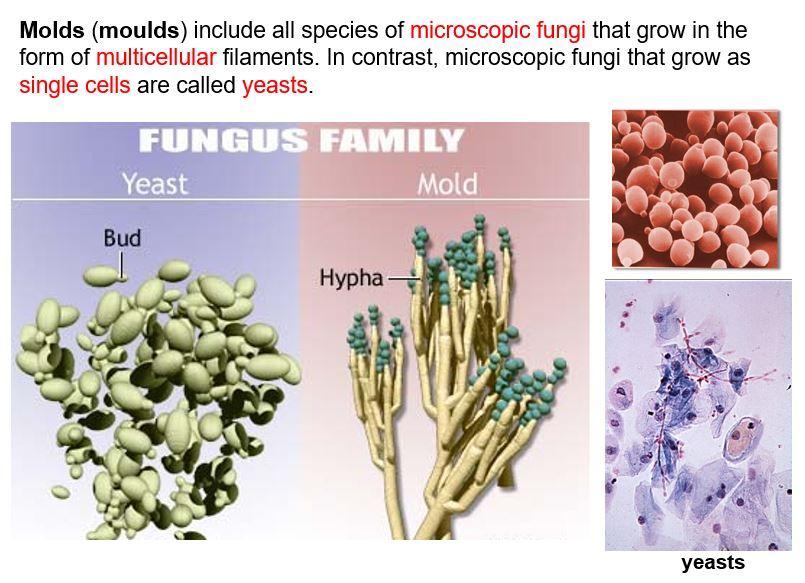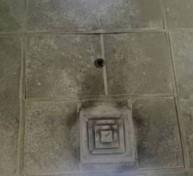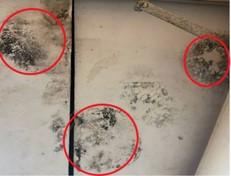Introduction
Fungus
Fungus growth is the growth of non-photosynthetic organism that ingests nutrients for its growth through phagocytosis; the process whereby fungal cells break down the infected cells.
Fungus is a term used to encompass living organisms belonging to the kingdom of fungi (Page and Trout, 2001). A distinctive characteristic that differentiates them from plants and algae is the absence of chlorophyll, despite having vegetative bodies like plants. This kingdom encompasses both macro organisms visible to the eye such as mushrooms and toadstools ; and microorganisms which constitute the mould patches found growing on building materials.
Mould
Mould (or its variant, mold) and mildew are generalized terms referring to fungus types that produce visible patches of growth on damp or decaying organic matter. These fungi constitute a significant number of known fungi within the kingdom, and thus the terms are frequently used interchangeably with fungus.
Mould do not need sunlight to grow. They are the microorganisms of the fungi kingdom that grow in the form of multicellular filaments (yeasts grow as single cells). The macroorganisms of the fungi kingdom include mushrooms and toadstools.


On surfaces shaded from the direct rays of the sun and where the humidity level is high, moulds rather than algae are the organisms that are likely to proliferate. Unlike algae, moulds are unable to synthesise their own food and thus have to rely on the medium on which they grow on to provide the nutrients necessary for their growth. Mould begin to grow when the relative humidity of the surface exceeds 70%, and for this reason, they are usually found on internal surfaces of buildings, such as in bathrooms and kitchens, and on ceiling boards, wallpaper and glass panels. They have also been found on façades where there is prolonged moisture retention or dampness, especially on water absorbing materials (Table 4.3).
Spores need three things to grow into moulds:
(1) Nutrients: Food for spores — organic matter, often cellulose, water absorbing.
(2) Moisture: Moisture is required to begin the decaying process caused by the mould.
(3) Time: Mould growth begins between 24 hours and 10 days from the provision of the growing conditions.

Fungus Characteristics
|
Characteristic
|
Description
|
|
Nutrition Derivation
| • Cannot photosynthesize like plants • Requires carbon and nitrogen for nourishment • Enzymes secreted to degrade nutrient source that cannot be absorbed |
|
Physical Structure and Growth
| • Eukaryotic in nature (cells with membrane-bound nuclei) like animals and plants • Presence of rigid cell walls like plants • Vegetative bodies exhibit growth at the tip |
|
Reproduction
| • By means of spores |
Mould on Building Materials
Mould structures can attach to a wide variety of substrates, including hard and non-biodegradable ones like hard rocks, metallic surfaces and glass that cannot provide nutrients. Sporulation further allows them to spread readily and colonise the same or other substrates in buildings and indoor environments (Swarup, 2004). Under favourable conditions for growth, all building materials can act as substrates for mould contamination.









Material Porosity and Penetration Risks
| Material Porosity | Risk of Moisture and Particle Penetration | Risk of Fungal Penetration |
| Non-porous | Low | Low |
| Semi-porous | Varying; depending on penetration of surface pores | Varying; depending on penetration of surface pores |
| Porous | High | High |
Material Porosity
The porosity of building materials affects the permeability of liquids and gases into the material (Chew and Tan, 2003). Where the material property allows for high absorption and retention of moisture, it is likely to remain damp. Airborne particles of nutrition value to mould can be easily trapped onto these surfaces, providing both moisture and nutrients for potential formation of fungal contamination.
Materials of high porosity have low resistance to biological attacks like mould growths, as deeper penetration of these microbial structures are to be expected, rendering the materials unsalvageable. Porosity further influences the reusability level of mould contaminated materials. Building materials can be categorized in three broad levels of porosity (NYCDH, 2000): Non-porous, semi-porous and porous.
Mould in the Indoor Environment
The indoor environment is a dynamic system consisting of complicated interacting factors.
Physical causes can hence be identified as improper and inadequate practices that concerns with one or more of these interactive factors to result in the combination of all the requirements of growth.
For example, the lack of workmanship of walls resulting in trapping of moisture in crack formations support fungal growth and concerns the factors ‘design and construction’, ‘moisture’ and ‘indoor microclimates’.

Factors Influencing Indoor Mould Growth

Ceiling Board Deteriorated by Mould
Effects on Building Materials
Biodeterioration
Biodeterioration can be caused by the activities growing of fungus. It is defined as any undesirable change in the properties in material of economic importance, Biodeterioration processes of mould growth can be due to the simultaneous actions of three behaviours, namely physical or mechanical, aesthetic and chemical deterioration.
Effects on Occupants
Potential health effects on humans due to fungal exposure range from allergic response, to infections and toxic response.
Hypersensitivity and Allergic Response
Allergens constitute to the development of allergic reactions. All fungal fragments of hyphae and spores can act as allergens to indoor occupants, as inhalation of such minute structures are possible. All allergic diseases involve 2 steps (Burge et al., 1997):
Sensitization:
The human body recognizes the specific allergen, for example, a particular type of fungus spore, when it is frequently exposed to the allergen for a long term
Subsequent Exposure:
Brings about allergic symptoms as means of body resistance against the foreign body
Fungal contamination can release volatile organic compounds (VOC) into the air, causing musty odours. Specific poisonous compounds can cause irritations, various SBS symptoms and possibly cancer.
Particular toxigenic mould spores contain non-volatile toxins harmful to exposed humans. Termed mycotoxins, they are complex in structures and diverse in variety. They can be acutely toxic, disrupting the functioning of the body activities, with potential harm to the nervous system (Samson et al., 1994).
Fungi are saprophytic, usually consuming organisms that are no longer living. Fungal infections occur when a fungus begins feeding off of a still-living organism. Symptoms occur when the body’s immune system is suppressed and fungi find an opportunity to invade the human body.
Also known as mycosis, infections are caused by pathogenic fungi. Generally fungi are not strongly pathogenic and seldom cause grave infections. Opportunistic fungal infection occurs and may become severe when a fungus enters a compromised host, as after the use of antibiotics, or in the case of other diseases, such as AIDS.
Certain fungus can invade human tissue and cause infectious disease when vulnerable hosts are encountered. Such fungi usually attack occupants with weak immune systems, such as children and the elderly. Underlying diseases or injury such as open wounds and AIDS (Acquired Immune Deficiency Syndrome) can contribute to infections.